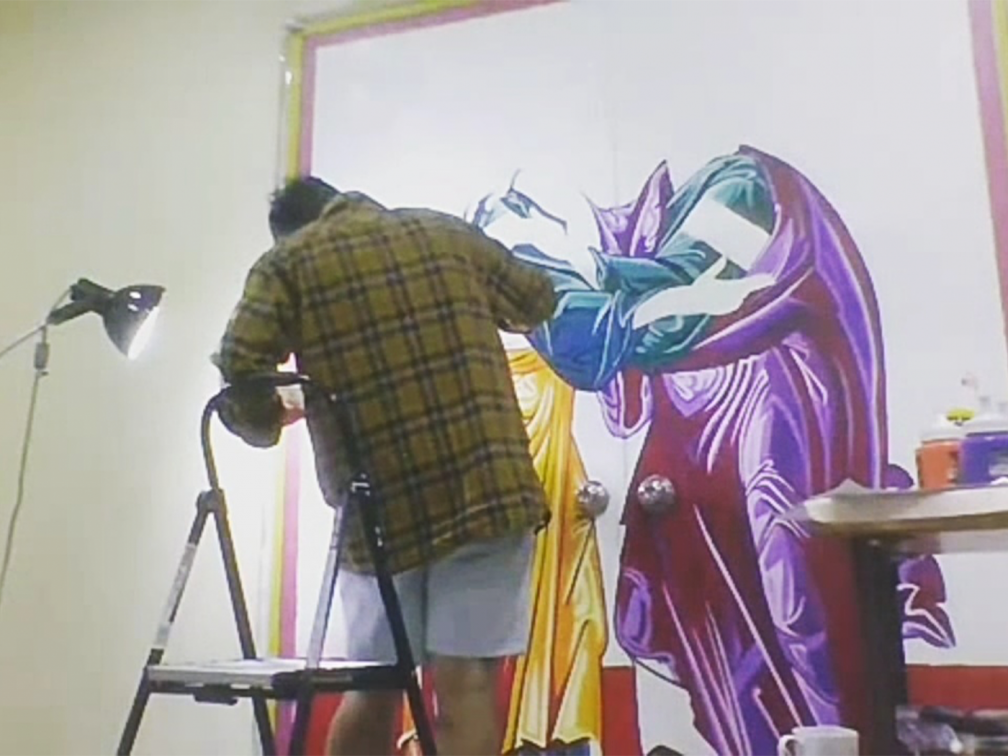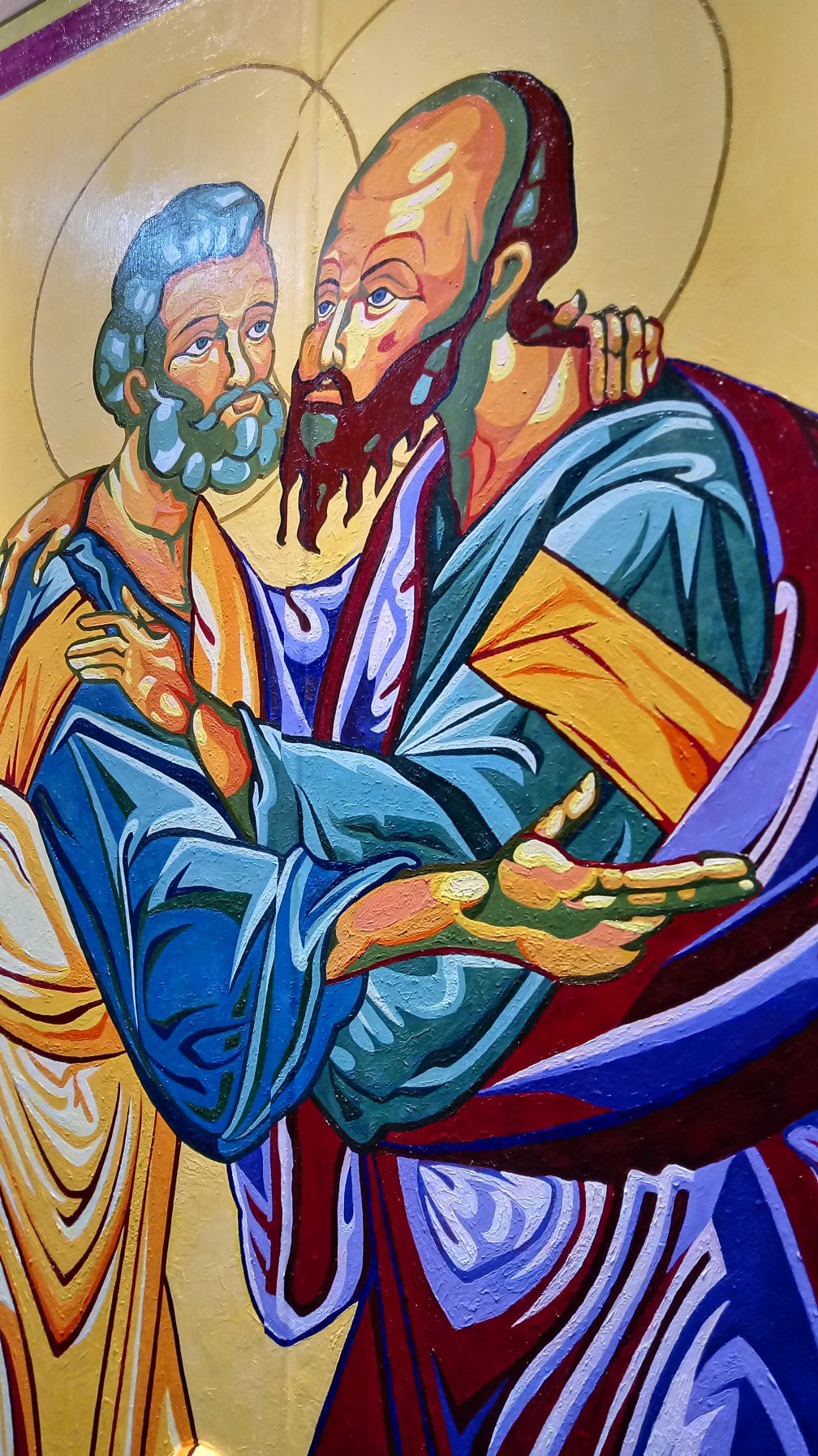The idea of a ‘painting’ on the door of a chapel was initiated and requested by the Columban Formation House. The goal was to transform the door’s bare look so that it could be better distinguished as a chapel door. The request was a big challenge to me in many ways; not least the door size and its metal surface. I needed to decide on a subject and work out the type of materials to use. I felt overwhelmed when I was first approached and asked to do this, however, I took it as a challenge, something which would support my ‘art ministry’. My confidence lay in the strong belief that God gave me this talent to serve others, so although I felt inadequate, I trusted God to guide me.
My first task was to determine what subject to paint. The process of choosing a subject was tough since I had to decide by myself instead of receiving instruction from someone else. Since most of my artwork is portraitures and human figures, the moment I saw the double-door entrance of the chapel I knew I would paint two human figures. If I were to paint human figures, the next question was who these figures should be. After asking for suggestions from fellow Columbans, one encouraged me to follow my heart – good advice!
I decided to choose Saints Peter and Paul to paint. On the surface level, the two of them seemed unlikely figures for a Columban. Usually, the saints I encounter are St. Patrick, St. Isidore, St. Mary and, not forgetting, St. Columban. In terms of a possible twosome to fit the two doors, it’s got to be our founders, Bishop Edward Galvin and Father John Blowick. How then did these foremost apostles and missionaries come into my sight? Any art that I do has to have, some form of personal connection with me and, in this case, it’s the feast of Saints Peter and Paul, which is June 29th, the day of my diaconate ordination in 2014. It had even more meaning, relevance and significance, having learnt that it is on the same feast day when, in 1918, the Society was canonically recognized as a missionary society by Bishop O’Dea of Galway, Ireland. Such decision to choose the two apostles led to more research, which opened my eyes to countless artworks by various artists about these two prominent apostolic-missionary figures in the Church.
The entire mural, from its images to its colours, is rich with symbolism that I intended to convey certain messages. Firstly, Saints Peter and Paul’s Embrace of Peace has been interpreted many times and in different ways by various artists in Christian arts, where Peter and Paul greeted each other with a Holy Kiss of Peace, which is an early Christians’ expression of love and peace. Apostle Paul, in some of his epistles, has instructed Christians to ‘Greet each other with the holy kiss of peace‘ (Romans 16:16). Later on, this expression, which was derived from Hebrew’s Shalom Aleikheim (May peace be upon you), has turned into the ‘Sign of Peace’ in the Mass.
Secondly, I used colours to represent the Church’s liturgical colours for all seasons. They also convey various cultural and religious virtues. Red signifies courage and martyrdom, purple signifies passion and zeal. Warmth and light are depicted by the colours yellow and orange, and life, hope and serenity; by the colours green and blue.
Thirdly, Peter and Paul’s faces touch but their eyes do not meet. This symbolizes the relationship of the two apostles. One was a fisherman and the other, a Roman citizen, whose opinions on faith, Gospel and Church were often different however their embrace embodies unity and acceptance of one another’s differences.
We usually relate to art by gazing in front of it however, this mural on the chapel door of Saints Peter and Paul invites us to move from a level of appreciation to enter into the art itself and to participate with Peter and Paul. By entering into the space of prayer, peace and love we participate in the shared mission of Peter and Paul, whom Christ called and sent to “preach the Gospel to all nations.”
Thirdly, Peter and Paul’s faces touch but their eyes do not meet. This symbolizes the relationship of the two apostles. One was a fisherman and the other, a Roman citizen, whose opinions on faith, Gospel and Church were often different however their embrace embodies unity and acceptance of one another’s differences.
We usually relate to art by gazing in front of it however, this mural on the chapel door of Saints Peter and Paul invites us to move from a level of appreciation to enter into the art itself and to participate with Peter and Paul. By entering into the space of prayer, peace and love we participate in the shared mission of Peter and Paul, whom Christ called and sent to “preach the Gospel to all nations.”
The mural took seven months to complete. When I look at it now, I relate to it beyond the symbolism I intended. I can’t look at it without remembering, aside from the back pain, my various feelings and experiences during the period of its making. I kept painting despite the pandemic and through all the emotions I felt during this challenging period. I kept brushing as I mourned the death of three great Columbans, Pat Murphy, Kevin O’Rourke and Frank Ferry in the Korea. While painting in solitude, I was not only deeply aware of, but confronted with what was happening in the world, in the Society as well as in myself.
So, the artwork, I would say, can speak on its own to different viewers in different ways and at different times. I remember a nun who upon seeing the mural told me she though it looked like a male counterpart of the visitation of Mary to her cousin Elizabeth. An art professor I know once reminded me, “The worst thing you could do to art is to explain it.” Let art speak the way God speaks to us. With that, as you gaze upon any artwork, I leave you with a quote from a Croatian artist, “Art speaks its own language: heart-to-heart, soul-to-soul.”




